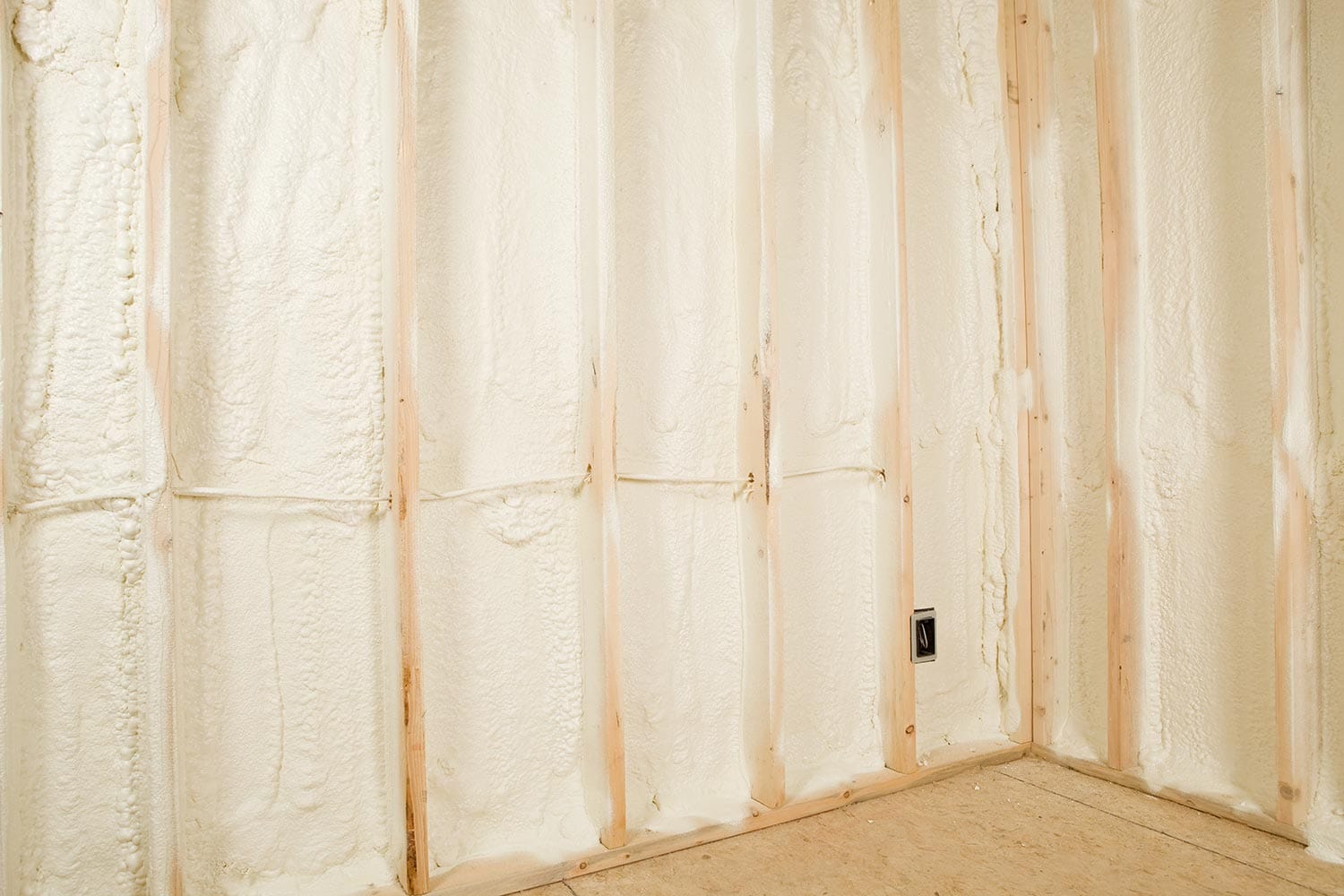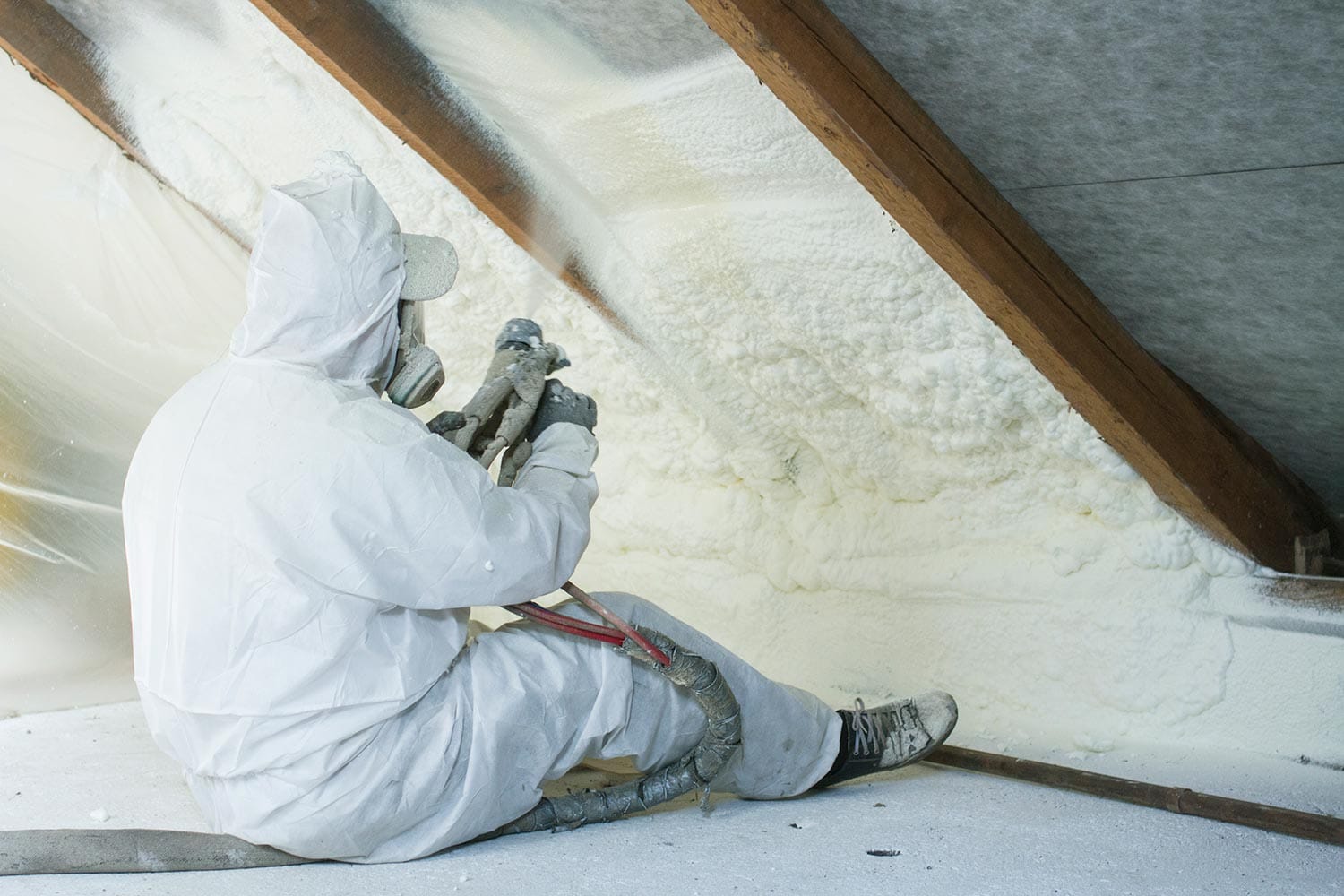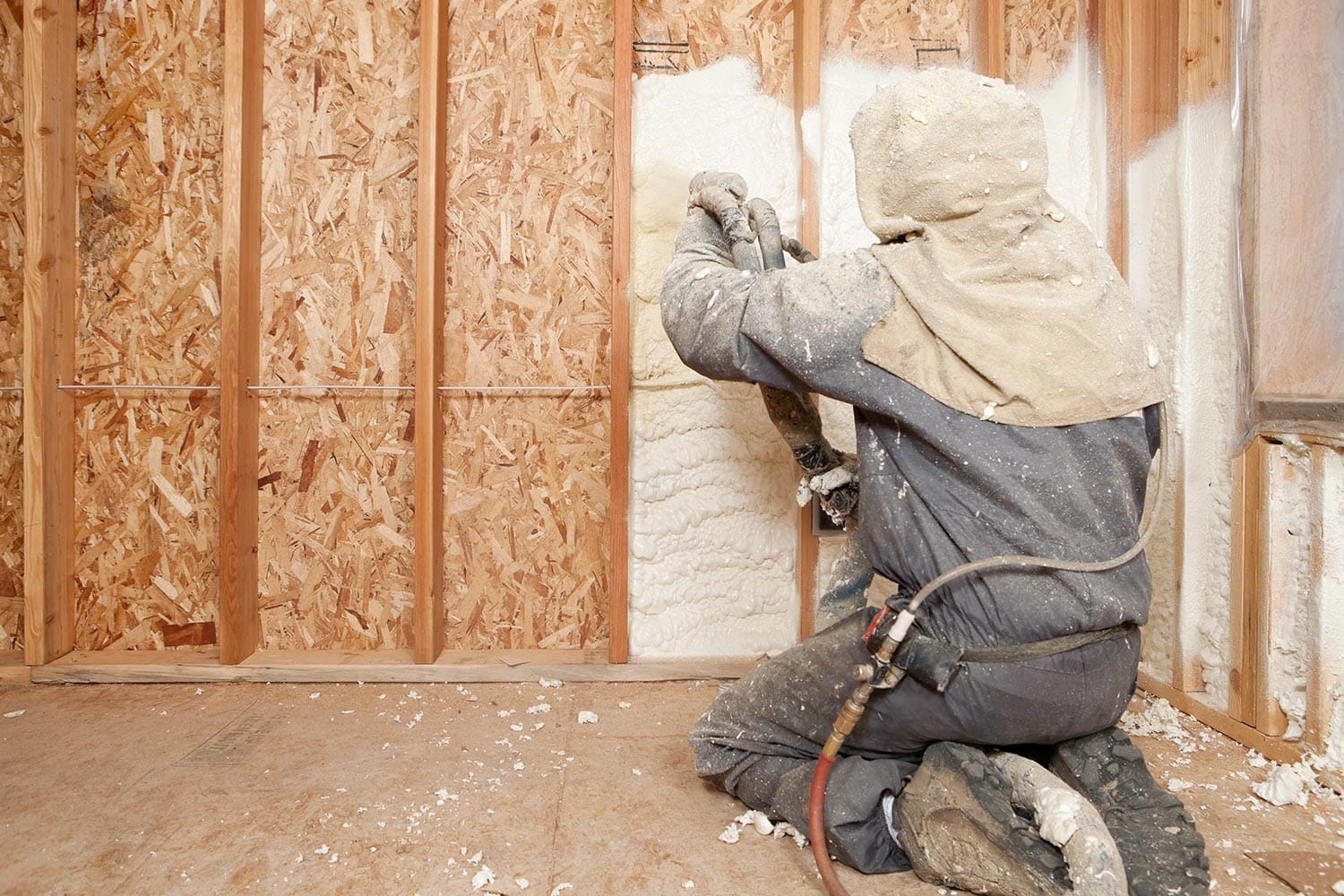Insulating your home is one of the best ways to ensure the efficiency of your HVAC system. However, applying it in the right thickness is also important. So how many inches of spray foam insulation should you apply? We searched for answers and here is what we got.
Usually, open-cell spray foam is recommended to be 6" to 10" thick on a roof deck or ceiling, and 3" thick on the walls, while closed-cell spray foam should be 4" to 5" thick on the ceiling and 2" to 3" thick on the walls.
However, it will still depend on the manufacturer's specification, where you live, and what part of your house you are insulating.
Read on as we present how much heat conduction is reduced by different spray foam insulation thicknesses. We'll also expound on how thick should the insulation be for certain parts of your home. Furthermore, we'll compare open-cell and closed-cell insulations and how much it costs to apply spray foam insulation.
![Worker spraying foam insulation on walls, How Much Spray Foam Insulation Do I Need [In Inches]?](https://hvacseer.com/wp-content/uploads/2022/06/How-Much-Spray-Foam-Insulation-Do-I-Need-In-Inches.png)
How Much Heat Flow Is Reduced By Spray Foam Per Thickness?
In the table below, you can see how much heat flow is reduced when you have different spray foam thicknesses:
|
Spray Foam Insulation* Thickness (in) |
Heat Flow Reduction (%) |
|
1 |
80 |
|
2 |
89 |
|
3 |
92 |
|
4 |
94 |
|
5 |
95 |
|
6 |
96 |
|
7 |
97 |
|
8 |
97 |
|
9 |
97 |
|
10 |
98 |
|
11 |
98 |
| 12 |
98 |
| *The type of spray foam is open-cell | |

In the table shown above, you can observe that the 10" and 12" thick spray foam reduces the same amount of heat.
You may have thought that the thicker your foam is, the higher the R-Value, but this isn't the case. R-Value is important, but it is heat resistance that R-Value measures.
The most crucial factor is that you have an air seal. Adding R-Value on top of R-Value reduces your return and wastes your money.
How Thick Should Spray Foam Insulation Be By Application Location?
Basement Walls

Depending on where you reside and whether you use open-cell or closed-cell insulation, your insulation thickness in basement walls will range from 2" to 7".
Ceiling/Roof Deck

As mentioned, if you plan to use open-cell spray insulation for your ceiling or roof deck, you must achieve a thickness of 6" to 10".
On the other hand, you should achieve a thickness of 4" to 5" if you want to use closed-cell spray insulation.
Walls

Closed-cell spray insulation should be 2" to 3" thick when used in walls. While open-cell spray should be 3" thick.
What Are The R-Values Of Each Spray Foam Type?
Spray foam insulation's R-Value varies based on the type, manufacturer, and other factors.
R-3.5 to R-3.8 per inch is the typical R-value of open-cell spray insulation. While R-6.5 to R-7 per inch is the R-value of closed-cell spray insulation.
Open-Cell Vs. Closed-Cell: What Are The Comparisons?
Let us now compare these two spray foam insulation types in terms of:
- material composition
- moisture permeability
- blowing agents
What Are Open-Cell and Closed-Cell Insulation Made of?
By mixing a polyisocyanurate (ISO) and a resin, open-cell spray foam insulation is made. The ingredients are kept apart until they are needed. The foam product is then created by spraying them onto a surface.
Closed-cell spray foam, on the other hand, is a spray-applied plastic product that offers constant insulation and an air barrier in certain areas of the home.
Moreover, closed-cell foam insulation is hard and very dense, but open-cell foam insulation is lightweight, malleable, and easy to work with.
How Permeable Are Open-Cell And Closed-Cell Insulations To Moisture?
Open-Cell:
Water can pass through open-cell foam since it is naturally moisture permeable. There are discrepancies in whether or not free-standing water can be absorbed depending on the spray foam manufacturer.
A good spray foam, for example, may only hold up to 5% of its weight in water. Other brands can hold up to 75% of their weight in water.
Closed-Cell:
This type of spray foam, on the other hand, is completely moisture impermeable, which means it does not allow water to pass through. While the moisture impermeable alternative may appear to be superior, open-cell can be advantageous on an attic roof deck.
What Blowing Agents Are Used In Open-Cell and Closed-Cell Insulation Installation?
Water is often used as the blowing agent in open-cell insulation.
Alternatively, closed-cell spray foam possesses a chemical ingredient that, in some cases, emits a transient odor.
Spray Foam Insulation Costs
The cost of insulating your home with spray foam insulation varies depending on whether you are using open-cell or closed-cell. In addition, using DIY spray foam kits may reduce the cost depending on the quality of materials used compared to employing professionals to do the job.
How Much Does A Spray Foam Kit Cost?
Here is a table of the price range of each spray foam insulation type:
Closed-Cell Spray Foam Kit:
- Low Price Range: $190
- Middle Price Range: $450 to $650
- High Price Range: $850
Open-Cell Spray Foam Kit:
- Low Price Range: $40
- Middle Price Range: $300 to $500
- High Price Range: $700
Notice that the closed-cell insulation kit is the more costly of the two alternatives. This is because it is more stiff, stable, and compact compared to open-cell foam, making it an excellent choice for insulating the insides of walls and other locations where structural integrity is important.
How Much Does It Cost To Hire Professionals To Apply Spray Foam Insulation?
Spray foam insulation costs anywhere from $1,284 to $3,741 to have professionally applied, with $2,492 as the national average cost.
How Much Does It Cost To Install Spray Foam In A Room?
Spray foam insulation costs anywhere from $1.00 to $4.50 per ft² of room area installed, varying according to the size of the project, the weather, the location, and whether the foam is open-cell or closed-cell.
To compute the insulation cost, you can use this formula:
- Cost= Room Area x Price Per ft²
For example, if you have a 224 ft² room, the cost would range from $224 to $1008.
How Much Does It Cost To Install Spray Foam In An Attic?

The cost of attic spray foam insulation ranges from $1 to $7 per ft². This will depend on how accessible your attic is and whether you'll need to employ a local electrician to inspect the wiring.
So if you have a 500 ft² attic area, the insulation cost ranges from $500 to $3,500.
Spray Foam Calculators
Nowadays, you don't have to worry if you don't know how much spray foam you need to insulate your home. There are spray foam calculators you can find on the web which help you determine the amount of insulation based on your specific need.
Some calculators, such as from Energy Efficient Solutions, only need the room area, insulation thickness, and application to determine the volume and board feet of spray foam you need.
What Are The Factors Affecting The Costing Of Spray Foam?
While the type of spray foam used is significant, it is not the only factor that influences the entire cost of spray insulation. Some of the factors are as follows:
- Siding of the building
- Size of insulation area
- Climate
- Location
Siding Of The Building
The siding of the property will make the contractors' job easy or difficult. Working with vinyl siding will be simple for professionals. This layer simply peels away, allowing a contractor to drill holes that will function as spray foam entrance points.
When you have brick siding, though, there is the additional effort needed. Installers would have to drill deep into the masonry merely to reach the spray foam injection point. After injecting the foam and ensuring that the cavities are filled, the contractors would need to fill in the drilled holes with mortar.
Size Of Insulation Area
The volume of spray foam needed for the project is largely determined by the area's size. If the entire structure, for example, requires spraying, more spray foam will be required.
If only a portion of the building requires spray foam, it would be less demanding.
Climate
The state of the climate is another crucial aspect of spray foam pricing. The spray foam is affected by changes in the weather. Closed-cell is suitable for areas where flooding must be controlled. Open-cell spray foam, on the other hand, is best suited to areas where flooding is unusual.
Location
Because different locations have different construction codes, the total cost of a building may be affected by its location. These codes influence both the overall spray foam quantity and the type of spray foam required.
What Are The Benefits Of Applying Spray Foam To Your Home?
If you want to apply spray foam to your home, here are some of the benefits you can enjoy:
- Fills even the tiniest cracks and crevices
- Airtight seal protects against moisture
- Reduces allergens that enter the home
- Easy to install, even in difficult to reach spots
- Reduces carbon footprint (as well as your energy bill)
- Long-lasting and stable
- Made of strong materials that improve the structural integrity of the house
- Also provides sound insulation
- While upfront costs can be high, it saves money in the long run due to its longevity
In Closing
The thickness of spray foam insulation you need to apply depends on various factors. However, a thickness of 2" to 3" is enough for walls, while ceiling/roofing deck insulation thickness ranges from 4" to 10", depending on the type of spray foam insulation you use.
Before you leave, if you're interested in learning more about spray foam insulation, you can check out these related articles:

Great article. Question for you, I had a spray foam company come and stray 2″ of closed cell on the ceiling of my garage. They were supposed to fill the rest with open cell but they did not. Should I insulate the last 2 inches of space with batts or will 5/8″ drywall and a gap be enough to do the job of sound proofing the ceiling? I have a feeling I should be putting 2″ batts in there before I sheet rock but won’t a space between the closed cell and the sheet rock be good? thanks for any insight you can give me